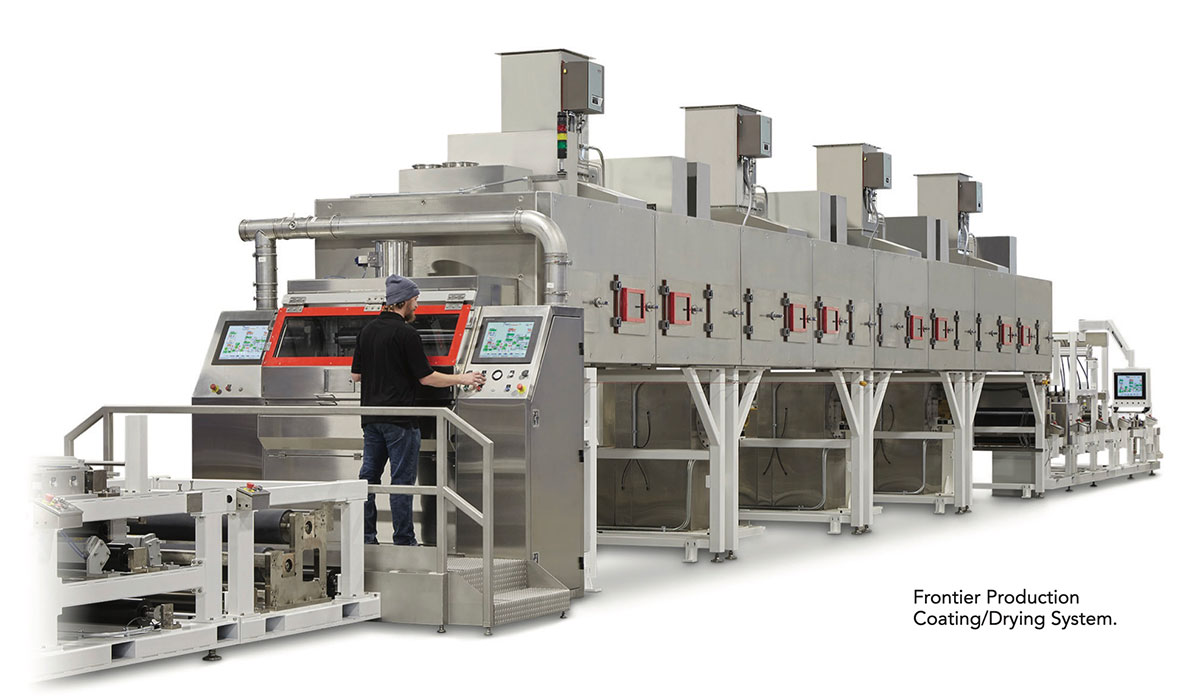Thin and Accurate is Slot Die Coating Standard
- Published: May 31, 2023

By Scott Zwierlein, Coating Engineer, FRONTIER – a Delta ModTech Company
Roll-to-roll slot die coating has become the industry standard for extremely thin and extremely accurate coating. Just how thin can slot die go? With a slot die, you can achieve an attainable wet coating thickness of <2 micron, but only slot die can achieve this level.
Why? It is the nature of the equipment design. Other methods will flood a large amount of coating, and then wipe it away. Slot die does the opposite. It applies the exact amount to the substrate. Everything the pump delivers is applied to the substrate — there is no waste.
Other methods, such as reverse roll, knife over roll and comma coating, use a device to wipe away excess coating leaving just the thickness desired. In this scenario you are requiring a blade or bar to be positioned 2 microns away from a substrate and that is almost impossible.
Extreme Accuracy
Accuracy is based on the amount of material you want to put down, how close you are, and how uniform you want it to be. You might be able to achieve 2 microns with other methods, but you cannot match the accuracy of slot die. With other coating methods the gap set for the blade, or the bar is fixed and the substrate and coating fluid pass through it. If the substrate thickness varies, the thickness will vary. The substrate you coat on is never that flat.
Important Attributes
A number of attributes need to be present to help slot die deliver on its promise. These attributes result in significant benefits over traditional methods in terms of functionality and cost savings:
- Precision pre-metered fluid delivery;
- Extremely flat and straight die surfaces;
- High-precision backing roll;
- Accurate and precise positioning of die to the substrate;
- Precision Die Vacuum System for coating bead stabilization; and,
- Contamination-free environment.
Stripe Coating
In battery and capacitor applications, for example, stripe coating is the preferred method when you are producing a narrow strip with exposed foil along one or both edges. One requirement for good stripe coating is uniform coating thickness — proper cavity design is essential.
You need proper die shim thickness for optimized die pressure; that produces the right uniformity for cross web production. It is also essential to have accurate width control and good edge quality — accurate shim design and fabrication is important to maintain the proper alignment. A die vacuum is used to fine-tune the width and to ensure there is no saw tooth or waviness.
Slot Die Coating Industries
Slot die is becoming increasingly necessary in a number of industries. Here are just a few applications: Micro-electronics (flat panel displays, thin circuits), batteries and capacitors (lithium-ion battery electrodes, multilayer ceramic capacitors), barrier films (food and medical packages), solar photo voltaic (solar cells require thin coatings) and medical diagnostics.
Variations in thickness can lead to differing results. The more accurate you coat the transdermal, the more accurate the dosage.
About the Author
As a Coating Engineer and Lab Manager at FRONTIER — a Delta ModTech company — Scott Zwierlein works directly with customers to develop solution-based coating and drying equipment. Solutions span a variety of industries, including batteries and capacitors, fuel cells and medical parts. With extensive problem-solving experience in the coating industry, Scott has been with Frontier (www.frontiercoating.com) for the past 20 years.




